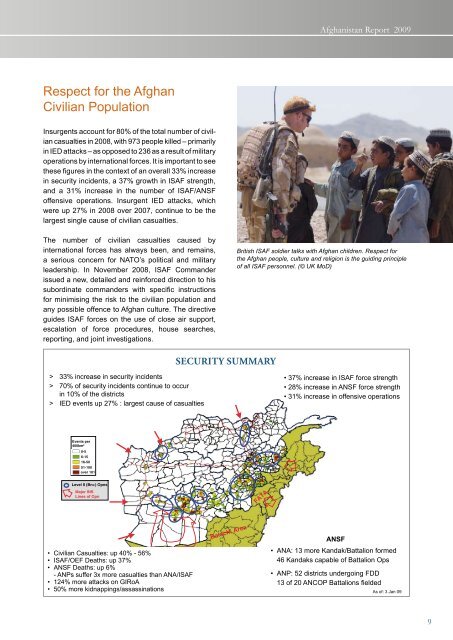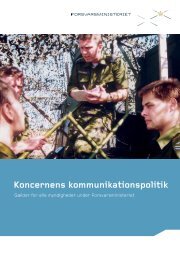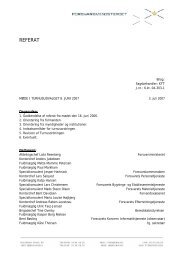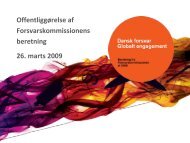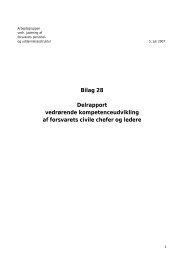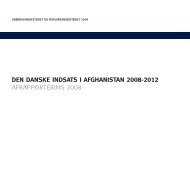Afghanistan Report 2009 - Isaf - Nato
Afghanistan Report 2009 - Isaf - Nato
Afghanistan Report 2009 - Isaf - Nato
Create successful ePaper yourself
Turn your PDF publications into a flip-book with our unique Google optimized e-Paper software.
<strong>Afghanistan</strong> <strong>Report</strong> <strong>2009</strong><br />
Respect for the Afghan<br />
Civilian Population<br />
Insurgents account for 80% of the total number of civilian<br />
casualties in 2008, with 973 people killed – primarily<br />
in IED attacks – as opposed to 236 as a result of military<br />
operations by international forces. It is important to see<br />
these figures in the context of an overall 33% increase<br />
in security incidents, a 37% growth in ISAF strength,<br />
and a 31% increase in the number of ISAF/ANSF<br />
offensive operations. Insurgent IED attacks, which<br />
were up 27% in 2008 over 2007, continue to be the<br />
largest single cause of civilian casualties.<br />
The number of civilian casualties caused by<br />
international forces has always been, and remains,<br />
a serious concern for NATO’s political and military<br />
leadership. In November 2008, ISAF Commander<br />
issued a new, detailed and reinforced direction to his<br />
subordinate commanders with specific instructions<br />
for minimising the risk to the civilian population and<br />
any possible offence to Afghan culture. The directive<br />
guides ISAF forces on the use of close air support,<br />
escalation of force procedures, house searches,<br />
reporting, and joint investigations.<br />
British ISAF soldier talks with Afghan children. Respect for<br />
the Afghan people, culture and religion is the guiding principle<br />
of all ISAF personnel. (© UK MoD)<br />
> 33% increase in security incidents<br />
> 70% ‣ 33% of security increase incidents security continue incidents to occur<br />
in 10% of the districts<br />
‣ 70% of security incidents continue<br />
> IED to events occur in up 10% 27% of : largest the districts cause of casualties<br />
‣ IED events up 27% : largest cause<br />
of casualties<br />
Security Summary<br />
Security Summary<br />
• 37% increase<br />
• 37%<br />
in ISAF<br />
increase<br />
force strength<br />
in ISAF force strength<br />
• 28% increase • 28% in ANSF increase force in strength ANSF force strength<br />
• 31% increase • 31% in offensive increase operations in offensive operations<br />
Events per<br />
400km 2<br />
0-5<br />
6-15<br />
16-50<br />
51-100<br />
0<br />
over 101<br />
Level II (Bn+) Opns<br />
Major INS<br />
Lines of Opn<br />
FATA<br />
• Civilian • Civilian Casualties: Casualties: up 40% up - 56% 40% - 56%<br />
• ISAF/OEF Deaths: up 37%<br />
• ISAF/OEF<br />
• ANSF<br />
Deaths:<br />
Deaths:<br />
up<br />
up<br />
37%<br />
6%<br />
• ANSF Deaths: - ANPsup suffer 6% 3x more casualties than ANA/ISAF<br />
- ANPs • 124% suffer more 3x more attacks casualties on GIRoA than ANA/ISAF<br />
• 124% • more 50% more attacks kidnappings/assassinations<br />
GIRoA<br />
• 50% more kidnappings/assassinations<br />
As of: 3 Jan 09<br />
Baluchi Area<br />
ANSF<br />
ANSF<br />
• ANA: 13 more<br />
• ANA:<br />
Kandak/Battalion<br />
13 more Kandak/Battalion<br />
formed<br />
formed<br />
46 Kandaks 46 Kandaks capable capable of Battalion of Battalion Ops Ops<br />
• ANP: 52 districts • ANP: undergoing 52 districts undergoing FDD FDD<br />
13 of 20 ANCOP Battalions fielded<br />
13 of 20 ANCOP Battalions fielded<br />
1 As of: 3 Jan 09<br />
9


